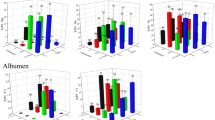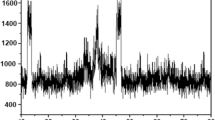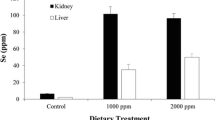Abstract
Selenium (Se) is an essential trace element for human health, and as a potential animal feed, the Chrysomya megacephala (Fabricius) fly is rich in protein and fat. By using different concentrations of sodium selenite (0, 30, 50, 70 mg kg−1), the possibility of biological Se enrichment in C. megacephala (Fabricius) maggots (CMMs) was investigated. The accumulation, Se speciation, enzymatic activity, and concentrations of copper (Cu), zinc (Zn), chromium (Cr), and cadmium (Cd) in the maggots were also determined. Transcriptomics was also used to investigate the mechanism of the Se response to CMM genes. The results showed that the CMMs had a survival rate of > 80% at Se exposure concentrations ranging from 0 to 100 mg kg−1. The optimal concentration of sodium selenite for CMM growth was 50 mg kg−1, and the weight, protein content, and total Se accumulation of the larvae (10.8 g, 53.5%, and 72.6 ± 3.36 mg kg−1 (DW), respectively) were considerably higher than the control and other exposure doses (p < 0.05). In addition, Se improved the ability of maggots to absorb Cu and Zn, decreased malondialdehyde (MDA) and lipid peroxidation, but improved the antioxidant activities of superoxide dismutase (SOD), catalase (CAT), and glutathione peroxidase (GPX). Furthermore, Se negatively affected the absorption of Cd and Cr. According to the transcriptomic findings, Se supplementation can boost protein synthesis and control both antioxidant and non-antioxidant enzyme activity in CMMs. Therefore, our findings showed that Se-enriched CMMs may counteract the toxicity of Cd and Cr, and Se is an effective supplement for improving the consumption safety of cultured animals fed containing CMMs.




Similar content being viewed by others
Data availability
All data generated or analyzed during this study are included in this published article.
References
Ahmad, H., Tian, J., Wang, J., Khan, M. A., Wang, Y., Zhang, L., & Wang, T. (2012). Effects of dietary sodium selenite and selenium yeast on antioxidant enzyme activities and oxidative stability of chicken breast meat. Journal of Agricultural and Food Chemistry, 60, 7111–7120.
Amato, R., Fontanella, M. C., Falcinelli, B., Beone, G. M., Bravi, E., Marconi, O., Benincasa, P., & Businelli, D. (2018). Selenium biofortification in rice ( Oryza sativa L.) sprouting: Effects on Se yield and nutritional traits with focus on phenolic acid profile. Journal of Agricultural and Food Chemistry, 66, 4082–4090.
Braeckman, B., Smagghe, G., Brutsaert, N., Cornelis, R., & Raes, H. (1999). Cadmium uptake and defense mechanism in insect cells. Environment Research, 80, 231–243.
Burk, R. F. (2002). Selenium, an antioxidant nutrient. Nutrition in Clinical Care, 5, 75–79.
Cheng, Z., Lam, C. L., Mo, W. Y., Nie, X. P., Choi, W. M., Man, Y. B., & Wong, M. H. (2016). Food wastes as fish feeds for polyculture of low-trophic-level fish: bioaccumulation and health risk assessments of heavy metals in the cultured fish. Environmental Science and Pollution Research, 23, 7195–7203.
Cheng, Z., Yu, L., Li, H., Xu, X., & Yang, Z. (2021). Use of housefly (Musca domestica L.) larvae to bioconversion food waste for animal nutrition and organic fertilizer. Environmental Science Pollution Research International, 28, 48921–48928.
Copat, C., Vinceti, M., D’Agati, M. G., Arena, G., Mauceri, V., Grasso, A., Fallico, R., Sciacca, S., & Ferrante, M. (2014). Mercury and selenium intake by seafood from the Ionian Sea: A risk evaluation. Ecotoxicological and Environmental Safety, 100, 87–92.
Dinh, Q. T., Cui, Z., Huang, J., Tran, T. A. T., Wang, D., Yang, W., Zhou, F., Wang, M., Yu, D., & Liang, D. (2018). Selenium distribution in the Chinese environment and its relationship with human health: A review. Environment International, 112, 294–309.
Dong, Z., Lin, Y., Wu, H., & Zhang, M. (2021). Selenium accumulation in protein fractions of Tenebrio molitor larvae and the antioxidant and immunoregulatory activity of protein hydrolysates. Food Chemistry, 334, 127475.
Gao, M., Lin, Y., Shi, G. Z., Li, H. H., Yang, Z. B., Xu, X. X., Xian, J. R., Yang, Y. X., & Cheng, Z. (2019). Bioaccumulation and health risk assessments of trace elements in housefly (Musca domestica L.) larvae fed with food wastes. The Science of the Total Environment, 682, 485–493.
GB13078, (2017). Hygienical standard for feeds. China National Standards Management Department, Beijing, China
Ge, J., Guo, K., Zhang, C., Talukder, M., Lv, M. W., Li, J. Y., & Li, J. L. (2021). Comparison of nanoparticle-selenium, selenium-enriched yeast and sodium selenite on the alleviation of cadmium-induced inflammation via NF-kB/IκB pathway in heart. Scice of the Total Environment, 773, 145442.
Gupta, M., & Gupta, S. (2016). An overview of selenium uptake, metabolism, and toxicity in plants. Frontiers in Plant Science, 7, 2074.
He, X., Nie, X., Wang, Z., Cheng, Z., Li, K., Li, G., Hung Wong, M., Liang, X., & Tsui, M. T. (2011). Assessment of typical pollutants in waterborne by combining active biomonitoring and integrated biomarkers response. Chemosphere, 84, 1422–1431.
Huang, G., Ding, C., Guo, F., Zhang, T., & Wang, X. (2018). The optimum Se application time for reducing Cd uptake by rice (Oryza sativa L.) and its mechanism. Plant and Soil, 431, 231–243.
Jarosz, M., Olbert, M., Wyszogrodzka, G., Mlyniec, K., & Librowski, T. (2017). Antioxidant and anti-inflammatory effects of zinc Zinc-Dependent NF-Κb Signaling. Inflammopharmacology, 25, 11–24.
Kieliszek, M. (2019). Selenium-fascinating microelement, properties and sources in food. Molecules, 24, 1298.
Ku, P., Wu, X., Nie, X., Ou, R., Wang, L., Su, T., & Li, Y. (2014). Effects of triclosan on the detoxification system in the yellow catfish (Pelteobagrus fulvidraco): Expressions of CYP and GST genes and corresponding enzyme activity in phase I, II and antioxidant system. Comparative Biochemistry and Physiology Part C: Toxicology & Pharmacology, 166, 105–114.
Li, Z., Yang, D., Huang, M., Hu, X., Shen, J., Zhao, Z., & Chen, J. (2012). Chrysomya megacephala (Fabricius) larvae: A new biodiesel resource. Applied Energy, 94, 349–354.
Lin, F., Zhang, H., Yu, J., Yu, C., Chen, C., Sun, Z., Wang, S., & Wen, X. (2021). Effects of dietary selenium on growth performance, antioxidative status and tissue selenium deposition of juvenile Chu’s croaker (Nibea coibor). Aquaculture, 536, 736439.
Luo, H., Yang, Y., Wang, Q., Wu, Y., He, Z., & Yu, W. (2020). Protection of Siganus oramin, rabbitfish, from heavy metal toxicity by the selenium-enriched seaweed Gracilaria lemaneiformis. Ecotoxicological and Environmental Safety, 206, 111183.
Navarro-Alarcon, M., & Cabrera-Vique, C. (2008). Selenium in food and the human body: A review. Science of the Total Environment, 400, 115–141.
Rahman, M. M., Hossain, K. F. B., Banik, S., Sikder, M. T., Akter, M., Bondad, S. E. C., Rahaman, M. S., Hosokawa, T., Saito, T., & Kurasaki, M. (2019). Selenium and zinc protections against metal-(loids)-induced toxicity and disease manifestations: A review. Ecotoxicological and Environmental Safety, 168, 146–163.
Reeves, P. G., & Chaney, R. L. (2004). Marginal nutritional status of zinc, iron, and calcium increases cadmium retention in the duodenum and other organs of rats fed rice-based diets. Environmental Research, 96, 311–322.
Rumpold, B. A., & Schluter, O. K. (2013). Nutritional composition and safety aspects of edible insects. Molecular Nutrition & Food Research, 57, 802–823.
Shen, H., Yang, C., Ding, W., Liu, J., & Ong, C. (2001). Superoxide radical–initiated apoptotic signalling pathway in selenite-treated HepG2 cells: Mitochondria serve as the main target. Free Radical Biology and Medicine, 30, 9–21.
Spurgeon, D. J., & Hopkin, S. P. (1999). Comparisons of metal accumulation and excretion kinetics in earthworms (Eisenia fetida) exposed to contaminated field and laboratory soils. Applied Soil Ecology, 11, 227–243.
USFDA, (2000). Food additives permitted in feed and drinking water of animals; selenium yeast. US Department of Health and Human Services, Center for Food Safety and Applied Nutrition, Washinton, DC, https://www.federalregister.gov/documents/2000/06/06/00-14214/food-additives-permitted-in-feed-and-drinking-water-of-animals-selenium-yeast. Accessed June 20, 2022
Van der Fels-Klerx, H. J., Camenzuli, L., van der Lee, M. K., & Oonincx, D. G. (2016). Uptake of Cadmium, Lead and Arsenic by Tenebrio molitor and Hermetia illucens from Contaminated Substrates. PLoS ONE, 11, 166–186.
Wang, W., Zhang, W., Wang, X., Lei, C., Tang, R., Zhang, F., Yang, Q., & Zhu, F. (2017). Tracing heavy metals in ‘swine manure - maggot – chicken’ production chain. Scientific Reports, 7, 8417.
Wrobel, J. K., Power, R., & Toborek, M. (2016). Biological activity of selenium: Revisited. IUBMB Life, 68, 97–105.
Xu, D., Liu, J., Gu, Y., Chen, Y., Zhao, C., Sun, G., Ren, Y., Li, C., & Xia., B. (2021). Biosynthesis and isotopic routing of dietary protein by sea cucumber Apostichopus japonicus (selenka): Evidence from compound-specific carbon stable isotope analysis. Journal of Agricultural and Food Chemistry, 69, 14802–14809.
Xu, Q., Shao, X., Shi, Y., Qian, L., Zhou, X., Qin, W., & Zhang, M. (2022). Is selenium beneficial or detrimental to earthworm? Growth and metabolism responses of Eisenia Fetida to Na2SeO3 exposure. Scice of the Total Environment, 807, 150770.
Yin, J., Wang, L., Wang, L., Huang, T., & Zhang, X. (2021). Pretreatment with selenium prevented the accumulation of hexavalent chromium in rainbow trout (Oncorhynchus mykiss) and reduced the potential health risk of fish consumption. Food Control, 122, 107817.
Young, M. D., Wakefield, M. J., Smyth, G. K., & Oshlack, A. (2010). Gene ontology analysis for RNA-seq: Accounting for selection bias. Genome Biology, 11, 14.
Yu, Q., Fu, Z., Huang, M., Xu, C., Wang, X., Qin, J., Chen, L., Han, F., & Li, E. (2021). Growth, physiological, biochemical, and molecular responses of Pacific white shrimp Litopenaeus vannamei fed different levels of dietary selenium. Aquaculture, 535, 736393.
Yue, S., Huang, C., Wang, R., & Qiao, Y. (2021). Selenium toxicity, bioaccumulation, and distribution in earthworms (Eisenia fetida) exposed to different substrates. Ecotoxicological and Environmental Safety, 217, 112250.
Yue, S., Zhang, H., Zhen, H., Lin, Z., & Qiao, Y. (2019). Selenium accumulation, speciation and bioaccessibility in selenium-enriched earthworm (Eisenia fetida). Microchemical Journal, 145, 1–8.
Zhang, K., Guo, X., Zhao, Q., Han, Y., Zhan, T., Li, Y., Tang, C., & Zhang, J. (2020). Development and application of a HPLC-ICP-MS method to determine selenium speciation in muscle of pigs treated with different selenium supplements. Food Chemistry, 302, 125371.
Zhang, X., Wang, Q., Zhang, J., Song, M., Shao, B., Han, Y., Yang, X., & Li, Y. (2022). The protective effect of selenium on T-2-induced nephrotoxicity is related to the inhibition of ROS-mediated apoptosis in mice kidney. Biological Trace Element Research, 200, 206–216.
Zhao, X., Zhao, Q., Chen, H., Xiong, H. (2019). Distribution and effects of natural selenium in soybean proteins and its protective role in soybean β-conglycinin (7S globulins) under AAPH-induced oxidative stress. Food Chemistry, 272, 201–209.
Zhao, Z., Barcus, M., Kim, J., et al. (2016). High dietary selenium intake alters lipid metabolism and protein synthesis in liver and muscle of pigs. Journal of Nutrition, 146, 1625–1633.
Zoidis, E., Pappas, A. C., Georgiou, C. A., Komaitis, E., & Feggeros, K. (2010). Selenium affects the expression of GPx4 and catalase in the liver of chicken. Comparative Biochemistry and Physiology. B: Biochemistry and Molecular Biology, 155, 294–300.
Acknowledgements
Financial support was provided by the Natural Science Foundation of Sichuan Province, China (2022NSFSC0237), Sichuan College Students Innovation and Entrepreneurship Training Program (202110626090), the Key Research and Development Program of Sichuan Province (2021YFN0018), National Natural Science Foundation of China (No. 21507095), Dean’s Research Fund of the Faculty of Liberal Arts and Social Sciences, The Education University of Hong Kong, Hong Kong SAR, China (DRF/ICSP-3 2021 and FLASS/DRF/IRS-4) and The Early Career Scheme, Research Grants Council of the Hong Kong SAR, China (Project no. 28300619).
Funding
The authors have not disclosed any funding.
Author information
Authors and Affiliations
Contributions
R-JP and CZ were involved in writing—original draft. Zhan-BY helped in data curation. X-XX contributed to supervision. MHW was involved in review & editing. YBM helped in review & editing, funding acquisition. ZC contributed to conceptualization, supervision, writing—review & editing, funding acquisition.
Corresponding author
Ethics declarations
Conflict of interest
The authors declare that they have no known competing financial interests or personal relationships that could have appeared to influence the work reported in this paper.
Ethics approval
The manuscript did not contain any reporting studies involving human data.
Consent for publication
The manuscript does not contain any individual person data.
Additional information
Publisher's Note
Springer Nature remains neutral with regard to jurisdictional claims in published maps and institutional affiliations.
Supplementary Information
Below is the link to the electronic supplementary material.
Rights and permissions
Springer Nature or its licensor (e.g. a society or other partner) holds exclusive rights to this article under a publishing agreement with the author(s) or other rightsholder(s); author self-archiving of the accepted manuscript version of this article is solely governed by the terms of such publishing agreement and applicable law.
About this article
Cite this article
Peng, R.J., Zheng, C., Yang, Z.B. et al. Selenium toxicity and bioaccumulation in selenium-enriched fly (Chrysomya megacephala) maggots. Environ Geochem Health 45, 4493–4503 (2023). https://doi.org/10.1007/s10653-023-01511-0
Received:
Accepted:
Published:
Issue Date:
DOI: https://doi.org/10.1007/s10653-023-01511-0




